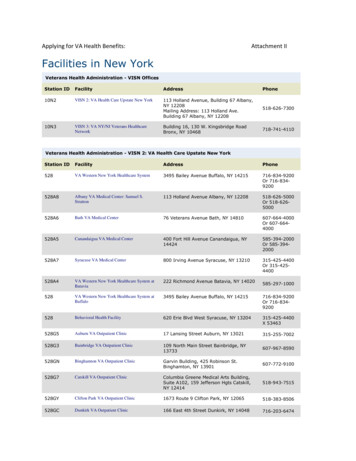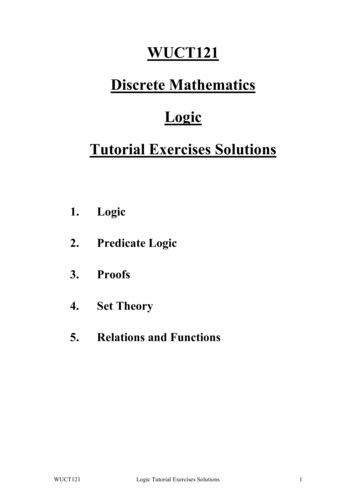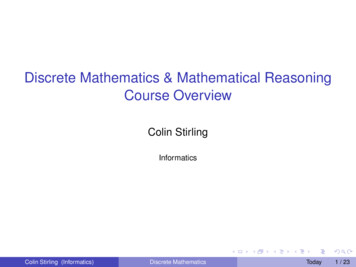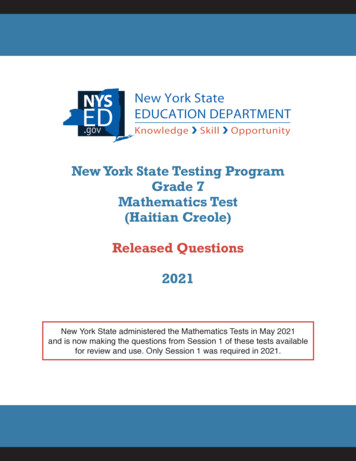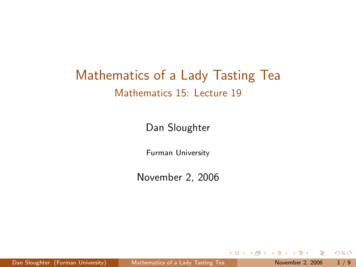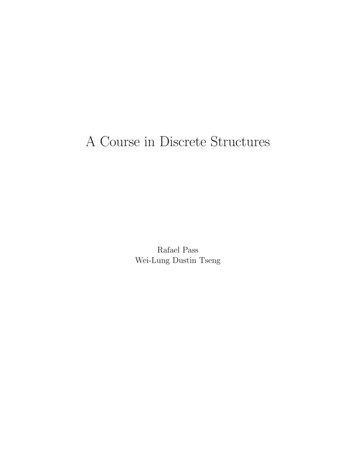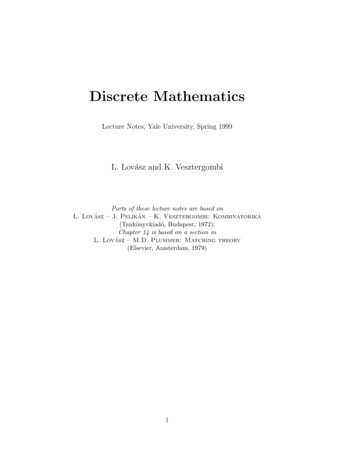
Transcription
Discrete MathematicsLecture Notes, Yale University, Spring 1999L. Lovász and K. VesztergombiParts of these lecture notes are based onL. Lovász – J. Pelikán – K. Vesztergombi: Kombinatorika(Tankönyvkiadó, Budapest, 1972);Chapter 14 is based on a section inL. Lovász – M.D. Plummer: Matching theory(Elsevier, Amsterdam, 1979)1
2
Contents1 Introduction2 Let2.12.22.32.42.5us count!A party . . . . . . . .Sets and the like . . .The number of subsetsSequences . . . . . . .Permutations . . . . .5.7791216173 Induction3.1 The sum of odd numbers . . . . . . . . . . . . . . . . . . . . . . . . . . . .3.2 Subset counting revisited . . . . . . . . . . . . . . . . . . . . . . . . . . . .3.3 Counting regions . . . . . . . . . . . . . . . . . . . . . . . . . . . . . . . . .212123244 Counting subsets4.1 The number of ordered subsets . . . .4.2 The number of subsets of a given size4.3 The Binomial Theorem . . . . . . . .4.4 Distributing presents . . . . . . . . . .4.5 Anagrams . . . . . . . . . . . . . . . .4.6 Distributing money . . . . . . . . . . .272728293032335 Pascal’s Triangle5.1 Identities in the Pascal Triangle . . . . . . . . . . . . . . . . . . . . . . . . .5.2 A bird’s eye view at the Pascal Triangle . . . . . . . . . . . . . . . . . . . .3535386 Fibonacci numbers6.1 Fibonacci’s exercise . . . . . . . . . . . . . . . . . . . . . . . . . . . . . . . .6.2 Lots of identities . . . . . . . . . . . . . . . . . . . . . . . . . . . . . . . . .6.3 A formula for the Fibonacci numbers . . . . . . . . . . . . . . . . . . . . . .454546477 Combinatorial probability7.1 Events and probabilities . . . . . . . . . . . . . . . . . . . . . . . . . . . . .7.2 Independent repetition of an experiment . . . . . . . . . . . . . . . . . . . .7.3 The Law of Large Numbers . . . . . . . . . . . . . . . . . . . . . . . . . . .515152538 Integers, divisors, and primes8.1 Divisibility of integers . . . .8.2 Primes and their history . . .8.3 Factorization into primes . .8.4 On the set of primes . . . . .8.5 Fermat’s “Little” Theorem .8.6 The Euclidean Algorithm . .8.7 Testing for primality . . . . .5555565859636469.3.
9 Graphs9.1 Even and odd degrees . . . . . . . . . . . . . . . . . . . . . . . . . . . . . .9.2 Paths, cycles, and connectivity . . . . . . . . . . . . . . . . . . . . . . . . .73737710 Trees10.1 How to grow a tree? . . . .10.2 Rooted trees . . . . . . . .10.3 How many trees are there?10.4 How to store a tree? . . . .818284848511 Finding the optimum11.1 Finding the best tree . . . . . . . . . . . . . . . . . . . . . . . . . . . . . . .11.2 Traveling Salesman . . . . . . . . . . . . . . . . . . . . . . . . . . . . . . . .939396.12 Matchings in graphs12.1 A dancing problem . . . . . . . .12.2 Another matching problem . . .12.3 The main theorem . . . . . . . .12.4 How to find a perfect matching?12.5 Hamiltonian cycles . . . . . . . .989810010110410713 Graph coloring11013.1 Coloring regions: an easy case . . . . . . . . . . . . . . . . . . . . . . . . . . 11014 A Connecticut class in King Arthur’s court11415 A glimpse of cryptography11715.1 Classical cryptography . . . . . . . . . . . . . . . . . . . . . . . . . . . . . . 11716 One-time pads16.1 How to save the last move in chess? . . . .16.2 How to verify a password—without learning16.3 How to find these primes? . . . . . . . . . .16.4 Public key cryptography . . . . . . . . . . .4. .it?. . .117118120120122
1IntroductionFor most students, the first and often only area of mathematics in college is calculus. Andit is true that calculus is the single most important field of mathematics, whose emergencein the 17th century signalled the birth of modern mathematics and was the key to thesuccessful applications of mathematics in the sciences.But calculus (or analysis) is also very technical. It takes a lot of work even to introduceits fundamental notions like continuity or derivatives (after all, it took 2 centuries justto define these notions properly). To get a feeling for the power of its methods, say bydescribing one of its important applications in detail, takes years of study.If you want to become a mathematician, computer scientist, or engineer, this investmentis necessary. But if your goal is to develop a feeling for what mathematics is all about,where is it that mathematical methods can be helpful, and what kind of questions domathematicians work on, you may want to look for the answer in some other fields ofmathematics.There are many success stories of applied mathematics outside calculus. A recent hottopic is mathematical cryptography, which is based on number theory (the study of positiveintegers 1,2,3,. . .), and is widely applied, among others, in computer security and electronicbanking. Other important areas in applied mathematics include linear programming, codingtheory, theory of computing. The mathematics in these applications is collectively calleddiscrete mathematics. (“Discrete” here is used as the opposite of “continuous”; it is alsooften used in the more restrictive sense of “finite”.)The aim of this book is not to cover “discrete mathematics” in depth (it should be clearfrom the description above that such a task would be ill-defined and impossible anyway).Rather, we discuss a number of selected results and methods, mostly from the areas ofcombinatorics, graph theory, and combinatorial geometry, with a little elementary numbertheory.At the same time, it is important to realize that mathematics cannot be done withoutproofs. Merely stating the facts, without saying something about why these facts are valid,would be terribly far from the spirit of mathematics and would make it impossible to giveany idea about how it works. Thus, wherever possible, we’ll give the proofs of the theoremswe state. Sometimes this is not possible; quite simple, elementary facts can be extremelydifficult to prove, and some such proofs may take advanced courses to go through. In thesecases, we’ll state at least that the proof is highly technical and goes beyond the scope ofthis book.Another important ingredient of mathematics is problem solving. You won’t be ableto learn any mathematics without dirtying your hands and trying out the ideas you learnabout in the solution of problems. To some, this may sound frightening, but in fact mostpeople pursue this type of activity almost every day: everybody who plays a game of chess,or solves a puzzle, is solving discrete mathematical problems. The reader is strongly advisedto answer the questions posed in the text and to go through the problems at the end ofeach chapter of this book. Treat it as puzzle solving, and if you find some idea that youcome up with in the solution to play some role later, be satisfied that you are beginning toget the essence of how mathematics develops.We hope that we can illustrate that mathematics is a building, where results are built5
on earlier results, often going back to the great Greek mathematicians; that mathematicsis alive, with more new ideas and more pressing unsolved problems than ever; and thatmathematics is an art, where the beauty of ideas and methods is as important as theirdifficulty or applicability.6
22.1Let us count!A partyAlice invites six guests to her birthday party: Bob, Carl, Diane, Eve, Frank and George.When they arrive, they shake hands with each other (strange European custom). Thisgroup is strange anyway, because one of them asks: “How many handshakes does thismean?”“I shook 6 hands altogether” says Bob, “and I guess, so did everybody else.”“Since there are seven of us, this should mean 7 · 6 42 handshakes” ventures Carl.“This seems too many” says Diane. “The same logic gives 2 handshakes if two personsmeet, which is clearly wrong.”“This is exactly the point: every handshake was counted twice. We have to divide 42by 2, to get the right number: 21.” settles Eve the issue.When they go to the table, Alice suggests:“Let’s change the seating every half an hour, until we get every seating.”“But you stay at the head of the table” says George, “since you have your birthday.”How long is this party going to last? How many different seatings are there (with Alice’splace fixed)?Let us fill the seats one by one, starting with the chair on Alice’s right. We can put hereany of the 6 guests. Now look at the second chair. If Bob sits on the first chair, we canput here any of the remaining 5 guests; if Carl sits there, we again have 5 choices, etc. Sothe number of ways to fill the first two chairs is 5 5 5 5 5 5 6 · 5 30. Similarly,no matter how we fill the first two chairs, we have 4 choices for the third chair, which gives6 · 5 · 4 ways to fill the first three chairs. Going on similarly, we find that the number ofways to seat the guests is 6 · 5 · 4 · 3 · 2 · 1 720.If they change seats every half an hour, it takes 360 hours, that is, 15 days to go throughall seating orders. Quite a party, at least as the duration goes!2.1 How many ways can these people be seated at the table, if Alice too can sit anywhere?After the cake, the crowd wants to dance (boys with girls, remember, this is a conservative European party). How many possible pairs can be formed?OK, this is easy: there are 3 girls, and each can choose one of 4 guys, this makes3 · 4 12 possible pairs.After about ten days, they really need some new ideas to keep the party going. Frankhas one:“Let’s pool our resources and win a lot on the lottery! All we have to do is to buyenough tickets so that no matter what they draw, we should have a ticket with the rightnumbers. How many tickets do we need for this?”(In the lottery they are talking about, 5 numbers are selected from 90.)“This is like the seating” says George, “Suppose we fill out the tickets so that Alicemarks a number, then she passes the ticket to Bob, who marks a number and passes it toCarl, . . . Alice has 90 choices, no matter what she chooses, Bob has 89 choices, so there are7
90 · 89 choices for the first two numbers, and going on similarly, we get 90 · 89 · 88 · 87 · 86possible choices for the five numbers.”“Actually, I think this is more like the handshake question” says Alice. “If we fill outthe tickets the way you suggested, we get the same ticket more then once. For example,there will be a ticket where I mark 7 and Bob marks 23, and another one where I mark 23and Bob marks 7.”Carl jumped up:“Well, let’s imagine a ticket, say, with numbers 7, 23, 31, 34 and 55. How many waysdo we get it? Alice could have marked any of them; no matter which one it was that shemarked, Bob could have marked any of the remaining four. Now this is really like theseating problem. We get every ticket 5 · 4 · 3 · 2 · 1 times.”“So” concludes Diane, “if we fill out the tickets the way George proposed, then amongthe 90 · 89 · 88 · 87 · 86 tickets we get, every 5-tuple occurs not only once, but 5 · 4 · 3 · 2 · 1times. So the number of different tickets is only90 · 89 · 88 · 87 · 86.5·4·3·2·1We only need to buy this number of tickets.”Somebody with a good pocket calculator computed this value in a glance; it was43,949,268. So they had to decide (remember, this happens in a poor European country) that they don’t have enough money to buy so many tickets. (Besides, they would winmuch less. And to fill out so many tickets would spoil the party. . .)So they decide to play cards instead. Alice, Bob, Carl and Diane play bridge. Lookingat his cards, Carl says: “I think I had the same hand last time.”“This is very unlikely” says Diane.How unlikely is it? In other words, how many different hands can you have in bridge?(The deck has 52 cards, each player gets 13.) I hope you have noticed it: this is essentiallythe same question as the lottery. Imagine that Carl picks up his cards one by one. The firstcard can be any one of the 52 cards; whatever he picked up first, there are 51 possibilities forthe second card, so there are 52 · 51 possibilities for the first two cards. Arguing similarly,we see that there are 52 · 51 · 50 · . . . · 40 possibilities for the 13 cards.But now every hand was counted many times. In fact, if Eve comes to quibbiz andlooks into Carl’s cards after he arranged them, and tries to guess (I don’t now why) theorder in which he picked them up, she could think: “He could have picked up any of the13 cards first; he could have picked up any of the remaining 12 cards second; any of theremaining 11 cards third;. . . Aha, this is again like the seating: there are 13 · 12 · . . . · 2 · 1orders in which he could have picked up his cards.”But this means that the number of different hands in bridge is52 · 51 · 50 · . . . · 40 635, 013, 559, 600.13 · 12 · . . . · 2 · 1So the chance that Carl had the same hand twice in a row is one in 635,013,559,600, verysmall indeed.Finally, the six guests decide to play chess. Alice, who just wants to watch them, setsup 3 boards.8
“How many ways can you guys be matched with each other?” she wonders. “This isclearly the same problem as seating you on six chairs; it does not matter whether the chairsare around the dinner table of at the three boards. So the answer is 720 as before.”“I think you should not count it as a different matching if two people at the same boardswitch places” says Bob, “and it should not matter which
discrete mathematics. (“Discrete” here is used as the opposite of “continuous”; it is also often used in the more restrictive sense of “finite”.) The aim of this book is not to cover “discrete mathematics” in depth (it should be clear from the description above that such a task would be ill-defined and impossible anyway). Rather, we discuss a number of selected results and .

